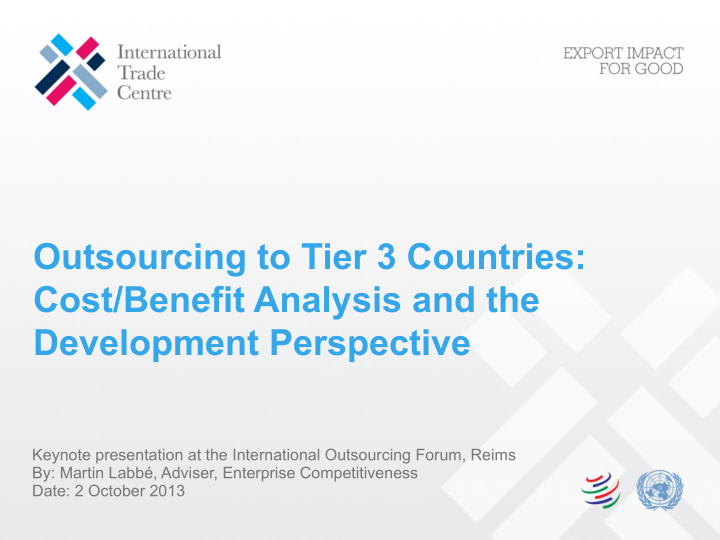



Outsourcing to Tier 3 Countries: Cost/Benefit Analysis and the Development Perspective Keynote presentation at the International Outsourcing Forum, Reims By: Martin Labbé, Adviser, Enterprise Competitiveness Date: 2 October 2013
What is ITC? ITC enables small business export success in developing countries by providing, with partners, trade development solutions to the private sector, trade support institutions and policy-makers
Putting ITC on the Map www.intracen.org
Content of the Presentation 1. Overview of global IT sourcing destinations, location rankings, and their limitations 2. Benefits of working with suppliers in tier 3 countries 3. Managing “tier 3” specific risks 4. The Development Contribution – Not Charity, Just Work
Overview of global IT sourcing trends
Global Opportunities, Local Game Changers • Expanding use of mobile phones and related services • Improved broadband connectivity • Cloud computing • Web-sourcing
Cloud-sourcing: the next generation of outsourcing? Source: Freelancer.com
Growth in the Global Sourcing Market (in B USD)
Casanearshore Park in Casablanca
French-speaking Africa: Morocco • 55/60 K employees, mostly young people • 800 M USD each year in revenues, mostly in French- and Spanish-speaking countries. • Strong infrastructure: Casanearshore Park • Captive centres: MedIT, BNP Paribas, Logica.. • +100 innovative local IT companies.
Teleperformance office in Tunis
French-speaking Africa: Tunisia • Offshoring industry employs + 25 K in BPO (+20 K), ITO (+3.5 K); R&D (1.5 K) • More than 1000 ITO/BPO companies • More than 70,000 multilingual graduates/ year, inculding 20 K engineers and scientists • Investments by Sungard, HP, Stream, Sagem, Altran, ADP, Téléperformance
Call Centre in Dakar
French-speaking Africa: Senegal • Mostly BPO, employs around 5000 people, 40+ companies • Mostly local players: PCCI, Call Me, Way2Call • Strategic sector for Senegal, means public support (incubators like CTIC) • Jokkolabs, local innovation hub initiative • IT companies mostly active on the West African market (People Input)
View of Abidjan, the Ivorian business capital
French-speaking Africa: Côte d’Ivoire • 300 IT companies > 10% are active in ITO/BPO • 3500 direct jobs – only a fraction on ITO/BPO • 0.25% of GDP (500 million USD). No figure on export volumes. • The National Polytechnic Institute, ESATIC and half a dozen private schools produce 1000 to 1500 IT graduates per year • Village des Technologies de l’Information et de la Biotechnologie à Grambassa
Global Trends
Developing countries need to focus on ITO/BPO niches
Overview of global location rankings, and their limitations
AT Kearney’s Global Services Location Index™ (GSLI) 2011 Asia dominates the top 10 positions
Gartner’s Top 30 Countries for Offshore Services
Tholons Top 100
A new-comer: the Towers Watson ranking The 39 countries in this ranking were selected on the basis of three criteria: (1) They are popular locations for services offshoring, (2) they are developing or newly industrialized countries and (3) they meet minimum standards of data availability.
Benefits of working with suppliers in tier 3 countries
How do you evaluate and manage “tier 3” specific risks?
Don’t apply a rigid, analytical grid on tier-3 countries Do tier-3 countries move up the value chain from Contact Centres, BPO to ITO? • Call centres considered as the entry-level market in offshoring – but highly dependent on connectivity • Does BPO only depend on cost arbitrage? • ITO as the highest segment – requires IT universities; at the same time, web development work is often undertaken by self-taught youngsters
Know the Usual Tier 3 Risks • Weak IT and Telco Infrastructure • Challenging business environment, including legal framework and IP protection • Lack of critical mass in human resources for larger operations • Cost competitiveness reduced by the lack of skill sets in certain areas
What else prevents tier-3 countries from growing market share on the global sourcing market? • Difficulty to mobilize the Government due to lack of reliable data • Lack of data worsened by the emergence of an online “grey economy”, particularly in developing and emerging countries • Domestic markets: lower ratio of software to hardware spending in developing countries in view of the industrial structure and level of automation
World Bank Location Readiness Index: Do Your Own Country Analysis http://www.infodev.org/en/Publication.875.html
World Bank Location Readiness Index: DIY Country Analysis • Around the 4 standard IT/ITES business lines: • Data processing • Voice processing • Knowledge services • IT services • Cost, Infrastructure, Business & Living Environment, Country Risk, Industry Maturity http://www.infodev.org/en/Publication.875.html
The Development Contribution – beyond CSR
Beyond CSR: Not Charity, Just Work • ATOS volunteers did PM training in Bangladesh • Set up a partnership with a local IT company • The Bangladeshi company is now part of their offshore supply network and works directly with some of their clients • Commitment, cost-competitiveness, available skill sets, risk diversification
Not Charity, Just Work
To summarize: 1. The pool of IT sourcing destinations goes beyond the usual group of countries analysts focus on 2. If properly evaluated, the risks of working with tier-3 countries are largely compensated by the benefits 3. The benefits are not only for your companies, they also have a Development dimension, but this is not about Charity - Just Work
labbe@intracen.org @ I T C n e w s Thank you!
How do you apply the risk-assessment process in, say, Bangladesh? A 3-step approach: 1. Assess the local IT & ITES industry using the WB model 2. Do desk research on local IT companies, with the help of the local IT association 3. Meet with your top 10 suppliers – online or during B2B events
Step 1: Use the sponsored materials for your data collection
Step 2: Use the local IT association to identify relevant companies
Step 3: Meet face-to-face with pre-selected local providers
Recommend
More recommend